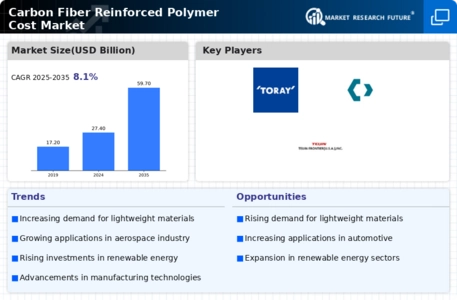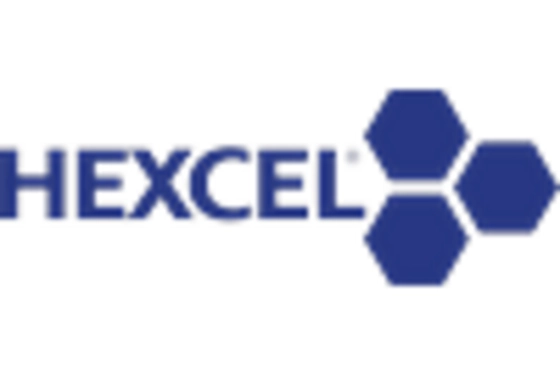The Carbon Fiber Reinforced Polymer (CFRP) Cost Market is currently characterized by a dynamic competitive landscape, driven by increasing demand across various sectors such as aerospace, automotive, and construction. Key players are actively engaging in strategies that emphasize innovation, sustainability, and regional expansion. For instance, Toray Industries (Japan) has positioned itself as a leader in high-performance materials, focusing on enhancing its production capabilities and expanding its global footprint. Similarly, Hexcel Corporation (US) is leveraging its technological expertise to develop advanced composite materials, thereby strengthening its market presence. These strategic initiatives collectively contribute to a competitive environment that is increasingly focused on differentiation through quality and innovation rather than merely competing on price.
In terms of business tactics, companies are increasingly localizing manufacturing to reduce costs and enhance supply chain efficiency. This approach appears to be particularly relevant in the CFRP market, which is moderately fragmented, with several players vying for market share. The collective influence of key players, such as SGL Carbon (Germany) and Mitsubishi Chemical Corporation (Japan), is shaping the market structure, as they invest in optimizing their supply chains and enhancing production processes to meet the growing demand for CFRP products.
In August 2025, SGL Carbon (Germany) announced a strategic partnership with a leading automotive manufacturer to develop lightweight composite materials aimed at reducing vehicle weight and improving fuel efficiency. This collaboration underscores SGL's commitment to innovation and sustainability, aligning with the automotive industry's shift towards greener technologies. The partnership is likely to enhance SGL's competitive edge by positioning it as a key supplier of advanced materials in the automotive sector.
In September 2025, Mitsubishi Chemical Corporation (Japan) unveiled a new production facility dedicated to the manufacturing of CFRP components for the aerospace industry. This facility is expected to significantly increase production capacity and reduce lead times, thereby enhancing Mitsubishi's ability to meet the growing demands of aerospace manufacturers. The establishment of this facility indicates a strategic move to solidify its position in a high-growth market segment, potentially leading to increased market share and revenue.
Furthermore, in July 2025, Teijin Limited (Japan) launched a new line of eco-friendly CFRP products, which are designed to meet the increasing demand for sustainable materials. This initiative not only reflects Teijin's commitment to environmental responsibility but also positions the company favorably in a market that is progressively leaning towards sustainability. The introduction of these products may attract environmentally conscious consumers and businesses, thereby enhancing Teijin's competitive positioning.
As of October 2025, the competitive trends in the CFRP market are increasingly defined by digitalization, sustainability, and the integration of advanced technologies such as artificial intelligence. Strategic alliances among key players are shaping the landscape, fostering innovation and enhancing supply chain reliability. Looking ahead, it appears that competitive differentiation will evolve, with a notable shift from price-based competition to a focus on innovation, technological advancements, and sustainable practices. This transition may redefine market dynamics, compelling companies to invest in R&D and collaborative ventures to maintain a competitive edge.


















Leave a Comment